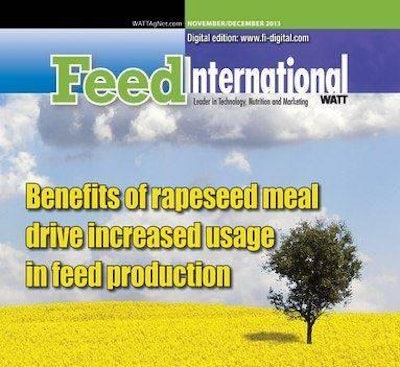
Containing more than 30 percent protein, rapeseed meal (or canola meal) is increasingly being used in feed for ruminants, pigs and poultry. Its high protein content makes it an attractive substitute for soybean meal. The secret to its recent success in the French feed industry is that the nutritional value of the byproduct is linked to changes in the crop and its processing.
Pascal Cerneau, R&D director with Glon Sanders, a French feed manufacturer that operates 23 plants and produces 3.4 metric million tons of feed, shares its experience: "[Glon Sanders] cut its incorporation of soybean meal in feed formulations by 50 percent over 10 years by using rapeseed meal and DDGS."
The company seized the opportunity to incorporate rapeseed meal into its production because of its high availability due to biofuel and oil production dedicated to food markets, e.g. salad oil, margarine, etc.
Rapeseed meal's rise in popularity
French production of rapeseed meal peaked at 2.5 million metric tons in 2011. Around 1.5 million metric tons are used in feed production compared with 2.2 million metric tons of soybean meal. The rest is mainly exported in the EU. The byproduct's incorporation into feed, which began to be significant at the end of the 1990s, has experienced a huge increase, jumping from 20 percent of total 2005 meal use in feed to 32 percent in 2010.
Rapeseed meal now makes up between 10 and 12 percent of total raw materials used in French feed plants. Half of its total usage is being consumed by ruminants; a quarter by pigs. The authorized incorporation level depends on the species. Rapeseed meal makes up to 50 percent of protein content in ruminant feed; around 20 percent in poultry (chicken or hen); and up to 30 percent in pig.
The benefits of rapeseed meal
Rapeseed meal is richer in fiber and fat - and poorer in proteins (around 33 percent) - than soybean meal, but its amino acid profile is useful for formulation with tryptophane, threonine, methionine, lysine and some minerals like phosphorus.
European countries dependent on soybean imports - and at the mercy of non-GMO premium price increases or/and volatility - favor rapeseed's GMO-free status because it gives them more flexibility to formulate for specific markets of GMO-free animal products. Rapeseed oil is also richer in Omega-3 than soybean oil, an advantage for its use in milking cow's ration for milk enrichment.
"The raw material is not pushed in our formula, but enters it when its price confirms the economic interest of its nutritional values," continues Cerneau.
Rapeseed meal overcomes its bad reputation
Rapeseed breeding selection focuses on a number of characteristics, such as oil and protein content, but also exclusion of anti-nutritional components. For example, glucosinolate avoidance is now achieved.
Feed manufactures have worked on sow use of rapeseed meal. The unpalatable meal was also known to be responsible for reduced feed intake, thyroid problems and reproductive performance degradation in pigs.
"We've gave 10 percent of rapeseed meal to sows during 18 months in two places: 600 sows in the center of France and 700 sow in the western part of France, in Brittany," Cerneau explains. "We didn't see any negative trend. On the opposite, we even increased the number of weaned piglets between +0.35 and +1.4 by sow.
Sinapine is another anti-nutritional component. In poultry, it gives eggs a fish-like taste, but only on certain breeds, e.g. brown hens, whose genetic evolution has helped eliminate this problem. Today, all hens have the enzyme used for sinapine degradation, known as TMA-free hens. Producers use as much as 16 percent of rapeseed meal in their feed without problems.
Attributes of rapeseed meal
Rapeseed meal and canola meal are both byproducts of oil production. Canola, however, is the name given to rape cultivars with low glucosinolate content.
Glucosinolates are very unpalatable, which causes animals to reduce their feed intake and results in a performance reduction with old crops. Therefore, plant breeders have developed varieties of rapeseed containing lower amounts of glucosinolates, which were initially referred to as low-glucosinolate rapeseed meal. Its name was changed to canola meal, which is commonly used today.
One of the major disincentives 20 years ago to using rapeseed meal was the glucosinolate content. Now, studies show that neither sow nor chicken production is affected by its use due to a drastic reduction in this anti-nutritional component in modern crops.
Apart from the components of the crop, the processing influences the product characteristics. Several studies have shown protein digestibility to decrease as the temperature at which the canola meal was processed increases.
Feedback given by the feed industry to the processing plants has reduced those differences as byproducts are increasingly being considered a co-product of oil. This change represents a major shift in the way the oilseed processing plants handle these materials.

















